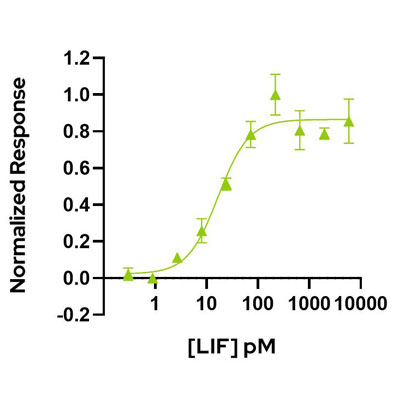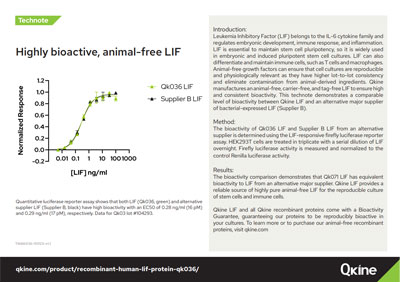Currency
Recombinant human LIF protein (Qk036)
Human LIF (leukemia inhibitory factor) suppresses the differentiation of murine embryonic stem cells (ESCs) and is widely used in ESC and induced pluripotent stem cell (iPSC) culture.
Qkine human LIF protein is a 17 kDa highly pure, bioactive, animal origin-free and carrier-protein free for reproducible results in stem cell culture.
Orders are typically shipped same or next day (except Friday).
Easy world-wide ordering, direct or through our distributors.
1000µg will be despatched as 2 x 500µg
Fast and free shipping.
Buy online with secure credit card or purchase order.
For any questions, please email orders@qkine.com
Summary
High purity human LIF protein (Uniprot: P15018)
>98%, by SDS-PAGE quantitative densitometry
17 kDa
Expressed in E. coli.
Animal origin-free (AOF) and carrier protein-free.
Manufactured in our Cambridge, UK laboratories
Lyophilized from acetonitrile, TFA
Resuspend in 10mM HCl at >100 µg/ml (provided with protein and free of charge), prepare single use aliquots, add carrier protein if desired and store frozen at -20°C or -80°C
Featured applications
Propagation of ES cells in feeder or feeder-free chemically defined culture systems
Human LIF can be used in the maintenance of murine ESCs
Human
Species similarity:
Bovine – 88%
Porcine – 87%
Rat – 83%
Mouse – 78%
Frequently used together
Bioactivity

Human LIF activity is determined using the LIF-responsive firefly luciferase reporter assay. HEK293T cells are treated in triplicate with a serial dilution of LIF overnight. Firefly luciferase activity is measured and normalised to the control Renilla luciferase activity. EC50 = 16.8 pM (0.29 ng/mL). Data from Qk036 lot #104293.
Purity

Human LIF protein (Qk036) migrates as a single band at 20 kDa in non-reducing (NR) and upon reduction (R). Purified recombinant human LIF protein (3 μg) was resolved using 15% w/v SDS-PAGE in reduced (+β-mercaptoethanol, R) and non-reduced conditions (NR) and stained with Coomassie Brilliant Blue R250. Data from Qk036 lot #104293.
Further quality assays
Mass spectrometry: single species with expected mass
Analytical reversed-phase: single sharp peak
Endotoxin: <0.005 EU/μg protein (below level of detection)
Recovery from stock vial >95%
We are a company founded and run by scientists to support innovation in stem cell biology and regenerative medicine. To enhance reliability and reproducibility in your applications, all our products are exceptionally high purity, with complete characterisation and bioactivity analysis on every lot.
Protein background
LIF is a pleiotropic factor that belongs to the IL-6 superfamily of cytokines. LIF is expressed as a 202 amino acid precursor which is processed by the removal of 22 animo acids from the N-terminus, which is important for receptor binding [1]. LIF acts through the heterodimeric receptor of LIFR (gp190)/gp130 [1, 2]. Although this receptor is shared by other cytokines, LIF stands out as it can have opposite effects depending on cell type, either stimulating or inhibiting cell proliferation and differentiation. LIF activates several cellular signaling pathways including the JAK/STAT, PI3K and MAPK pathways [1].
LIF signaling is essential for maintenance of murine ESC pluripotency through STAT3 signaling [2]. In neural stem cell (NSC) culture LIF can have complex and potentially contradictory effects. LIF enhances NCS self-renewal but can also promote gliogenesis, depending on the context and presence of other growth factors, such as epidermal growth factor (EGF) and fibroblast growth factor 2 (FGF2) [3].
Publications
Self-renewing human naïve pluripotent stem cells dedifferentiate in 3D culture and form blastoids spontaneously
In Nature Communications on 22 January 2024 by Guo, M., Wu, J., Chen, C. et al.
Metabolic rewiring underpins human trophoblast induction
Preprint on 18 Mar, 2024 by Jan Żylicz, Karlien van Nerum, Anne Wenzel, Lidia Argemi Muntadas, et al.
KLF7 is a general inducer of human pluripotency
Preprint on 6 September 2023 by Arboit, M. et al.
ERK signalling orchestrates metachronous transition from naïve to formative pluripotency
Preprint on 20 July 2023 by Mulas, C. et al.
STAT3 and HIF1α cooperatively mediate the transcriptional and physiological responses to hypoxia
In Cell Death Discovery on 5 July 2023 by Dinarello, A. et al.
Genome-wide screening in pluripotent cells identifies Mtf1 as a suppressor of mutant huntingtin toxicity
In Nature Communications on 5 July 2023 by Ferlazzo, G. M. et al.
Esrrb guides naive pluripotent cells through the formative transcriptional programme
In Nature Cell Biology on 27 April 2023 by Carbognin, E. et al.
Generating human blastoids modelling blastocyst-stage embryos and implantation
In Nature Protocols on 15 February 2023 by Heidari Khoei, H., Javali, A., Kagawa, H. et al.
FAQ
Leukemia inhibitory factor (LIF) is an interleukin 6 class cytokine, named for its ability to induce the terminal differentiation of myeloid leukemia cells.
In the early developing embryo, LIF is expressed in the trophectoderm.
LIF binds to the heterodimeric receptor LIFR (gp190)/gp130.
LIF activates several cellular signaling pathways including the JAK/STAT, PI3K and MAPK pathways.
LIF can be added to feeder-free stem cell cultures, it promotes self-renewal by recruiting signal transducer and activator of transcription 3 (Stat3).
Our products are for research use only and not for diagnostic or therapeutic use. Products are not for resale.




What others are saying
There are no contributions yet.